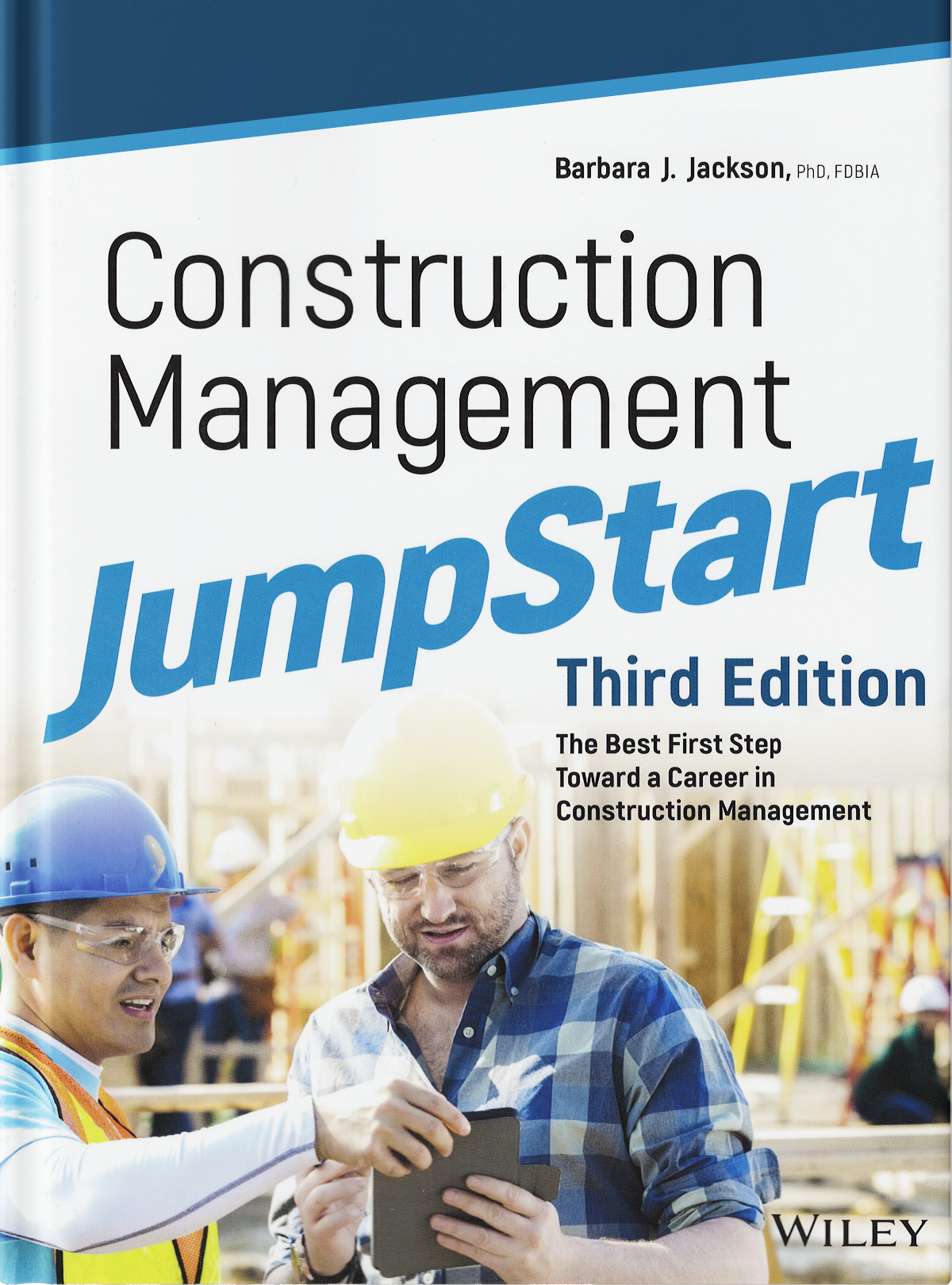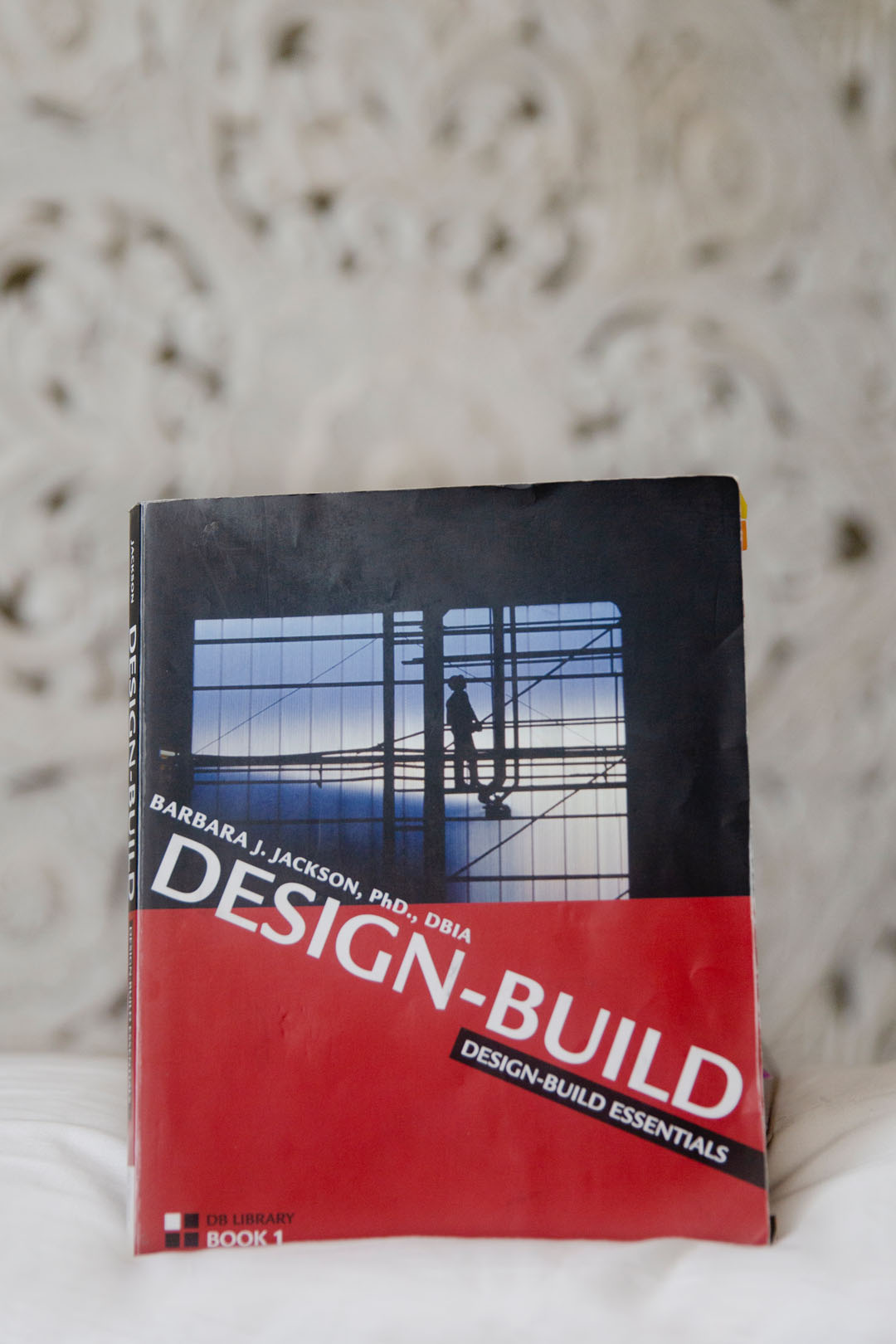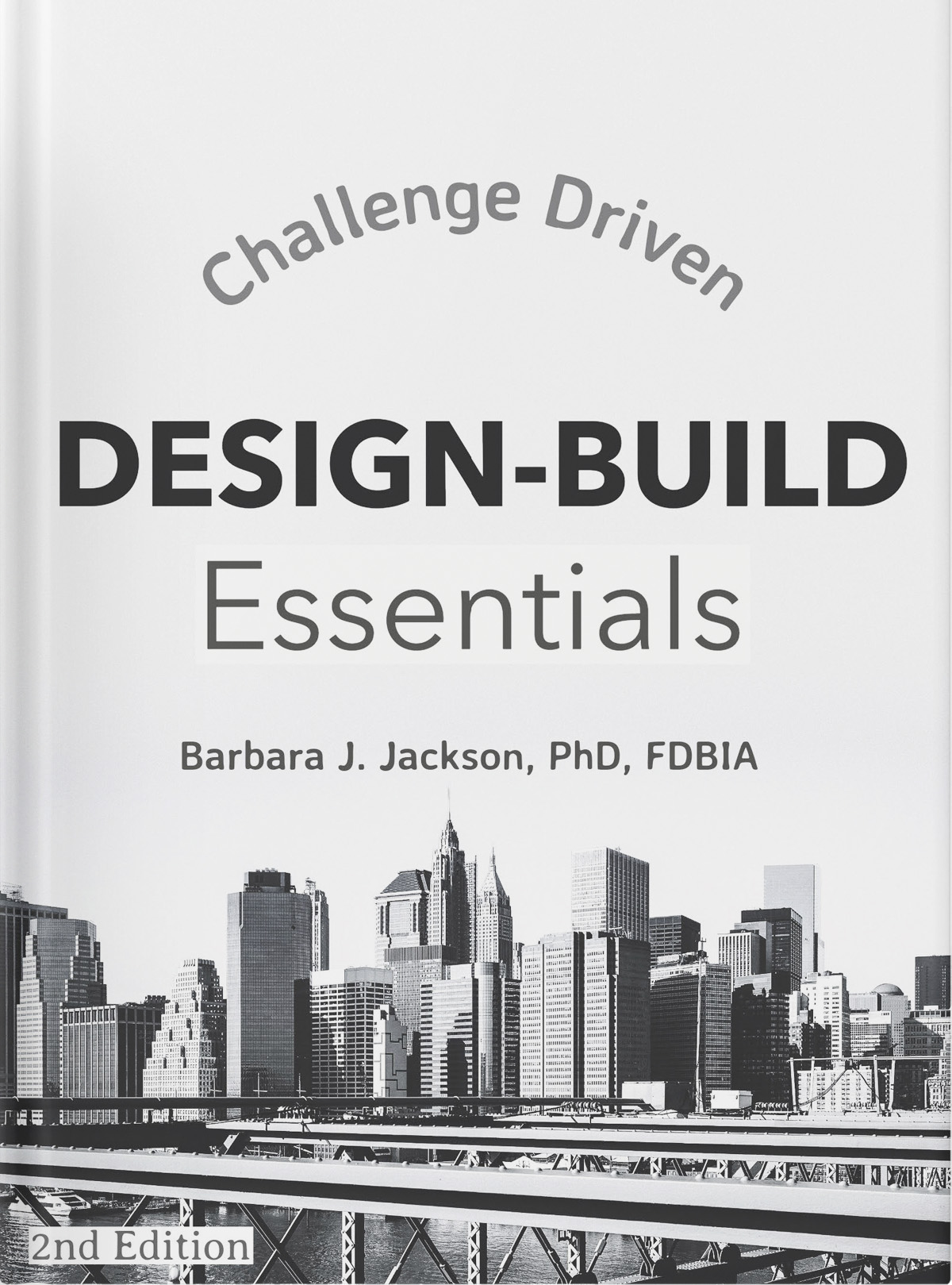Design-Build Essentials
Design-Build Essentials
Available for purchase
This practical, multi-disciplinary guide brings you all of the fundamentals that constructors, architects, and engineers must understand in order to mitigate risks, optimize results, and be successful in the design-build arena. Design-Build Essentials is truly a design-builder’s resource, as well as the ideal introduction and reference for the student of design-build. It addresses the fact that design-build requires the unique integration of both design and construction functions by featuring input from all of the various players associated with delivering a design-build project. Opening with an introduction to the industry and fundamental distinctions of design-build, the book progresses to cover managing the design-build process and the integrated design build team, concluding with a look at the future of the industry.
Inside this Edition
Clear, straightforward, conversational writing style keeps readers engaged, while instilling need-to-know design-build principles
Case studies and real project examples from the top design-builders in the US offer insight into the real-world challenges and unique solutions associated with design-build project delivery
Industry quotes from contractors, architects, engineers, and owners add credibility and currency to the book from an industry perspective
Mentoring moments from recent college graduates working in the design-build environment provide a clear and direct link between theory and real-world experience which will be of keen interest to current students
Take away tips provide practical advice that can be incorporated into design-build practice immediately
Chapter 1 Excerpt
Transformation of an Industry
If you look up the word “transformation” in the dictionary you will find a definition that reads something like this: Transformation – a noticeable change in character, appearance, function or condition. There is no doubt that the design and construction industry has evolved throughout its history. We have come a long way from building huts with mud and straw, using rocks and timber as our tools. Today advanced materials, methods, and technologies, such as Global Positioning Systems (GPS), computer-aided earth moving systems, robotics, and four- and five-dimensional visualization techniques, as well as high performance steel, super-strength concrete and advanced polymers, can be used on any given project. But these types of industry advances, although remarkable, still represent independent, isolated improvements—in other words, nothing that fundamentally changes the traditional process and approach associated with designing and constructing buildings and structures.
Today, however, we stand on the verge of a revolutionary transformation—and at the heart of this transformation is a progressive merging of minds unlike anything we have seen before. Contractors, architects, engineers, and owners are closer than ever to collaborating across all functions of the design and construction process, with design-build, combined with other integration strategies, at the forefront. Combine this merging of minds with new integration technologies, such as Building Information Modeling (BIM), and the “most collaborative” generation of young, tech savvy design and construction professionals in history, and it seems that we may be very close to a tipping point that could alter the way we do business forever—a revolutionary breakthrough. In his book Leading the Revolution, Gary Hamel calls this kind of innovation non-linear innovation, because it goes beyond incremental improvement into the development of a whole new business concept. According to Hamel, “the gap between what can be imagined and what can be accomplished has never been smaller.”
We have just scratched the surface of the potential capabilities of the design-build approach for delivering highly successful projects. The fact is, traditional roles, thinking, and contracting methods have kept us from taking advantage of the efficiencies, creativity, innovations, and extraordinary results that an integrated design-build process can deliver. In other words, “the way we have always done things” is getting in the way of “getting things done.” Design-build, when it is executed and managed correctly, can simultaneously reduce costs, shorten schedules, and improve performance, thereby adding the kinds of value that project owners are clamoring for today.
INCREASED COLLABORATION AND INTEGRATION
Part of the evolution of design-build has entailed an increased emphasis on collaboration and integration, particularly among contractors and designers. Many have recognized that the real power of the process is the ability to leverage the various perspectives and collective intelligence of the primary design-build players. By working together in a collaborative fashion, the owner has the greatest opportunity to achieve superior results, the project team will optimize efforts, and risks are reduced for all concerned. Two pivotal publications have drawn increased industry attention to these important concepts.
The Collaborative Process Institute White Paper
In 1996 a group of concerned owners, contractors, engineers, and architects met in San Francisco to discuss the deteriorated state of the industry. The outcome was the publication of a white paper entitled “Collaboration in the Building Process” (October 8, 1996), and the creation of the Collaborative Process Institute (CPI). This organization, founded by some of the key AEC innovation leaders in the nation, laid out in the open what many people had been feeling for years. No one was satisfied with the way things were going in the industry—not owners, not designers, and not contractors. The CPI declared that the industry’s woes could not be solved by tweaking project delivery methods alone. It would take work on the people side of the equation as well.
At the core of the Collaborative Process is the assertion that optimized projects result when the design and construction process seeks an integration of people and systems. The group identified seven maxims which underpin the Collaborative Process:
1 Integrity and trust are essential for true collaboration.
2 The long run is more important than the short run.
3 Teams make better choices than individuals.
4 In building a team, prequalify firms and select people.
5 True creativity focuses on option generation.
6 Change is inevitable: be prepared for it.
7 The basis for decision making should be facts and reason, not opinions and emotion.
Although the organization has since disbanded, the ideas and concepts outlined in their 1996 white paper are a perfect fit with the philosophy of design-build. Many of the people who were involved with creating the Collaborative Process Institute are still working hard, through different venues, to continue the efforts that the group initiated. They recognized early on that the potential of the AEC industry was being hindered by the continued fragmentation and adversarial environment that surrounded the design and construction process. The group realized that the full benefit of collaboration could only be achieved when both the designer and the contractor were selected early in the process when the scope definition, budget, and schedule were being established. They also suggested that contracts be negotiated on an open-book basis whereby all project participants could see the true costs associated with the project. Furthermore, the CPI insisted that the senior management of all parties extend their full commitment and support to the process. Most former CPI members attribute the suspension of the organization to a lack of owner involvement and support.
CURT White Papers
In 2000 a group of owners organized to create the Construction Users Round Table (CURT)—an offshoot of the Construction Committee of the Business Round Table which had been around for over thirty years. Identifying itself as “The Owners Voice to the Construction Industry,” the members of CURT represent construction and engineering executives of some of the largest corporations in America. The mission of the Construction User’s Roundtable, according to their website, is to help create competitive advantage for construction users in the marketplace. As an organization, CURT is dedicated to promoting excellence in the creation of capital assets by providing aggressive leadership.
A special CURT task force was assigned to address the perception of inadequate, poorly coordinated AE (architecture and engineering) drawings, errors and omissions, and similar challenges and difficulties commonly experienced in the design and construction process. The task force determined that these issues were actually indicators of a much larger problem within the industry. In August of 2004, CURT published a white paper entitled “Collaboration, Integrated Information, and the Project Lifecycle in Building Design, Construction and Operation.” In this paper, CURT concluded that:
The difficulties experienced in typical construction projects, including those identified by CURT members, are artifacts of a construction process fraught by lack of cooperation and poor information integration. The goal of everyone in the industry should be better, faster, more capable project delivery created by fully integrated, collaborative teams. Owners must be the ones to drive this change, by leading the creation of collaborative, cross-functional teams comprised of design, construction, and facility management professionals.
In July 2006, CURT published a second white paper entitled “Optimizing the Construction Process: An Implementation Strategy.” In this document CURT concluded that wholesale industry change is necessary to achieve the levels of collaboration and team integration necessary to optimize project results.
The CURT white papers represent a breakthrough in the transformation of the AEC industry. There are many individual practitioners, firms, and organizations like the CPI that have worked tirelessly to integrate the design and construction industries over the years—long before there was a CURT organization. So efforts to improve collaboration, integration, and project optimization have been made in previous approaches. What is new is that for the first time in the industry’s history, it appears that all stakeholders are finally looking in the same direction. The primary reason for the failure of the 1996 CPI initiatives, lack of owner participation, may now be changing: Owners are now recognizing that they play a huge part in achieving the full collaboration necessary for an integrated solution. Without their participation, all other efforts will most likely fall short.
BACK TO THE FUTURE
A common thread runs through all of the advances of the past forty years—a search for better, more efficient ways to deliver design and construction services to the public. It has been a bumpy road at times. But we have come full circle and almost everyone involved in the design and construction process, contractors, architects, engineers, and owners, are recognizing that the industry’s dysfunction can no longer be tolerated. Many of our traditional policies, procedures, and prejudices are hindering the integration process. The major forces that can influence how we do business in the future are finally beginning to align.
It has been a long time since the days of the Master Builder and the idea that a single person could anticipate all of the needs and challenges associated with a complex project and plan, design, manage, and construct a building or facility single-handedly. Today’s Master Builder is the Integrated Design-Build Team. Although that team needs the skills, knowledge, and experience to deal with the technical aspects of a project, more importantly, they need to accompany them with the more difficult soft skills of communication, facilitation, and collaboration in order to fully integrate the project solution. This part of the transformation process has not been easy to achieve. For too long, the complex role that people play in project delivery has been ignored or misunderstood. But in the end, it’s the “people portion” of the equation that will make the biggest difference.
The New Master Builder
These are exciting times in the AEC industry. For many, they are also unsettling times. The old foundations underlying our traditional ways of doing business, our traditional roles, our traditional ways of interacting with one another, are crumbling under the weight of necessity, change and opportunity. The demands and challenges of the marketplace coupled with technological advances are causing barriers to fall and lines to be blurred.
Those who have not grasped the magnitude of this industry transformation will be unprepared to keep up with the pace of change that is sure to occur over the next decade. In the book The Next Architect: A New Twist on the Future of Design (2007) by James P. Cramer, founding editor of DesignIntelligence, and Scott Simpson, president and CEO of Stubbins Associates, the authors conclude:
As owners seek more streamlined delivery of their projects, they will increasingly turn to design-build, contracting with a single entity to provide integrated design and construction services. This will encourage the traditionally factional and fractional design and construction industry to find new ways of collaborating. The shift to design-build will also substantially affect issues of risk management, since so many formally competitive entities will be linked by a common contractual bond. Essentially, design-build is a return to the traditional role of the Master Builder.
Whether you are a seasoned practitioner or a young student about to graduate from the university, everyone will be affected by this transformation; everyone will have a role to play and a contribution to make as we redefine how we do business together as design and construction professionals. Design-build is a model that provides an opportunity to bring out the best in each of us, but only when all key players understand and execute it correctly. The purpose of this book is to provide an understanding of the fundamental concepts that are unique to design-build and that allow this approach to work at its highest potential.
Even if you feel you already know how to do design-build, this book can still provide you with valuable information about the practices and techniques to help you maximize the process. If you think design-build is not much different than design-bid-build, this book will demonstrate design-build’s unique requirements and character. If you think design-build simply means that now the contractor gets to “control” the architect, you will find the approach is much more complex than that. As you will learn in Chapter 3, there’s very little about the design-build process that is like design-bid-build. But before we discuss that, we will first examine the basic project delivery and procurement options available, and why design-build has become so popular.
Chapters
Pages
“Testimonial or quote? Or your own thoughts on the new edition, what can be expected…?”
Name
Company
Location
New Edition
Coming in 2022
The 2nd edition of Design-Build Essentials will include much of the informative content that was presented in the first edition with relavant updates throughout. In addition, the 2nd edition will cover many new relevant topics such as:
> Progressive Design-Build
> Being an Engaged Owner
> Developing a Design-Build Culture
> Leading the Design-Build Team
> Mitigating Risks Across the Team
> Contracting Approaches that Work
> And many more.
About the author.

Barbara Jackson is Director of the Franklin L. Burns School of Real Estate & Construction Management in the Daniels College of Business at the University of Denver. She is also a professor of Construction Management and Design-Build at DU. She holds a BS in Housing & Design, an MS in Construction Management, and a PhD in Education and Human Resources. With over 30 years of experience as a licensed contractor and design-builder, she is a nationally recognized speaker and consultant on alternative project delivery, integrated project leadership, high performance teaming, and the transforming culture of the AEC industry.
“Today the career opportunities in the construction industry are greater than ever. The advances in technology and the complexity of projects demands expertise way beyond simply pounding nails and erecting steel. The learning and growth opportunities across all sectors of the industry are expanding and the rewards are significant—both financially and professionally. If you are looking for a challenging career and enjoy seeing the fruits of your labor manifest in real buildings and structures, Construction Management just might be for you!”
Barb
Barb’s Books & Contributions

Design-Build Essentials

Construction Management Jumpstart

Regenerative Urban Development
Guest Author

Journey’s Out of Homelessness
Guest Author


